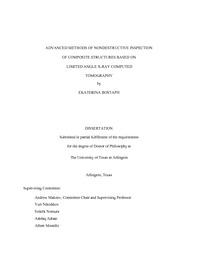
ATTENTION: The works hosted here are being migrated to a new repository that will consolidate resources, improve discoverability, and better show UTA's research impact on the global community. We will update authors as the migration progresses. Please see MavMatrix for more information.
Show simple item record
| dc.contributor.advisor | Makeev, Andrew | |
| dc.creator | Bostaph, Ekaterina | |
| dc.date.accessioned | 2017-10-02T15:09:32Z | |
| dc.date.available | 2017-10-02T15:09:32Z | |
| dc.date.created | 2017-08 | |
| dc.date.issued | 2017-09-01 | |
| dc.date.submitted | August 2017 | |
| dc.identifier.uri | http://hdl.handle.net/10106/27003 | |
| dc.description.abstract | This research aimed to study the potential for breaking through object size limitations of current X-ray computed tomography (CT) systems by implementing a limited angle scanning technique. CT stands out among other industrial nondestructive inspection (NDI) methods due to its unique ability to perform 3D volumetric inspection, unmatched micro-focus resolution, and objectivity that allows for automated result interpretation. This work attempts to advance NDI technique to enable microstructural material characterization and structural diagnostics of composite structures, where object sizes often prohibit the application of full 360o CT. Even in situations where the objects can be accommodated within existing micro-CT configuration, achieving sufficient magnification along with full rotation may not be viable.
An effort was therefore made to achieve high-resolution scans from projection datasets with limited angular coverage (less than 180º) by developing effective reconstruction algorithms in conjunction with robust scan acquisition procedures. Internal features of inspected objects barely distinguishable in a 2D X-ray radiograph can be enhanced by additional projections that are reconstructed to a stack of slices, dramatically improving depth perception, a technique referred to as digital tomosynthesis. Building on the success of state-of-the-art medical tomosynthesis systems, this work sought to explore the feasibility of this technique for composite structures in aerospace applications. The challenge lies in the fact that the slices generated in medical tomosynthesis are too thick for relevant industrial applications.
In order to adapt this concept to composite structures, reconstruction algorithms were expanded by implementation of optimized iterative stochastic methods (capable of reducing noise and refining scan quality) which resulted in better depth perception. The optimal scan acquisition procedure paired with the improved reconstruction algorithm facilitated higher in-plane and depth resolution compared to the clinical application. The developed limited angle tomography technique was demonstrated to be able to detect practically significant manufacturing defects (voids) and structural damage (delaminations) critical to structural integrity of composite parts. Keeping in mind the intended real-world aerospace applications where objects often have virtually unlimited in-plane dimensions, the developed technique of partial scanning could potentially extend the versatility of CT-based inspection and enable game changing NDI systems. | |
| dc.format.mimetype | application/pdf | |
| dc.language.iso | en_US | |
| dc.subject | NDI | |
| dc.subject | Computed tomography | |
| dc.subject | Tomosynthesis | |
| dc.subject | Limited angle | |
| dc.subject | Composites | |
| dc.subject | Structural diagnostics | |
| dc.subject | Defects | |
| dc.subject | Delamination | |
| dc.title | ADVANCED METHODS OF NONDESTRUCTIVE INSPECTION OF COMPOSITE STRUCTURES BASED ON LIMITED ANGLE X-RAY COMPUTED TOMOGRAPHY | |
| dc.type | Thesis | |
| dc.degree.department | Mechanical and Aerospace Engineering | |
| dc.degree.name | Doctor of Philosophy in Aerospace Engineering | |
| dc.date.updated | 2017-10-02T15:11:39Z | |
| thesis.degree.department | Mechanical and Aerospace Engineering | |
| thesis.degree.grantor | The University of Texas at Arlington | |
| thesis.degree.level | Doctoral | |
| thesis.degree.name | Doctor of Philosophy in Aerospace Engineering | |
| dc.type.material | text | |
| dc.creator.orcid | 0000-0002-1113-3787 | |
Files in this item
- Name:
- BOSTAPH-DISSERTATION-2017.pdf
- Size:
- 12.04Mb
- Format:
- PDF
This item appears in the following Collection(s)
Show simple item record


